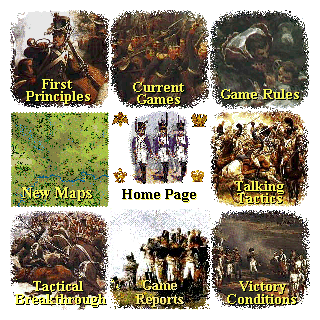|
|
|
Battles played out between individuals or groups will be listed, along with their effects on the players' relative positions in a ladder of all participants. Wins and losses can send a player up or down in relation to everyone else, leaping over others less active, less successful or just less lucky - they will say ;-)
The Players' Ladder
Rather than awarding different points for different levels of result, the NHWC system is to award promotion and demotion on a ladder according to the players' relative positions on it when the battle started. It is important to log these positions, as they may change during the battle if others are being fought by either player concurrently.
There are 6 relative positions considered for our purposes:
Any player may challenge any other, lower ranking players against higher ones at their own risk but for potentially greater gain.
No player may refuse a challenge without good reason, such as being currently engaged in at least one battle. Commitments external to the NHWC are of course good reasons, but in this case the player should have himself marked up here as unavailable.
Any new player will join the ladder at the bottom and will work their way up according to their skills and abilities.
Results and Effects
The following table shows the effect of each type of result on a player's ladder position, according to the relative positions of the opponents as listed above. i.e. Case 2 means the player was 2 rungs higher than his opponent at the start, etc.
Case |
Overwhelming defeat |
Major defeat |
Minor defeat |
Draw |
Minor victory |
Major victory |
Overwhelming victory |
1 |
-3 |
-2 |
-1 |
-1 |
0 |
0 |
+1 |
2 |
-2 |
-1 |
-1 |
0 |
0 |
+1 |
+1 |
3 |
-1 |
-1 |
0 |
0 |
+1 |
+1 |
+2 |
4 |
-1 |
0 |
0 |
+1 |
+1 |
+2 |
+2 |
5 |
0 |
0 |
+1 |
+1 |
+2 |
+2 |
+3 |
6 |
0 |
+1 |
+1 |
+2 |
+2 |
+3 |
+3 |
Some examples to illustrate this table:
a) A player 4 rungs above his opponent at the start of a battle (case 1) suffers a minor defeat by him. Their original ranking would mean the higher player being expected to gain a victory, so in defeat he goes down one rung. The lower-placed victor (case 6) gets a promotion of 2 places up the ladder for his achievement of a minor victory.
b) Two players just 2 places apart on the ladder (positions 5 and 7). The higher is classed as case 2; he wins a major victory and gains only one rung up the ladder. His opponent is in case 5 and would be expected to not do well, so he retains his place on the ladder.
Constant reshuffling
The effect of the above results is to keep the relative positions of players ever changing as long as there are some game results coming in. Players at the top will have to get at least some sort of victory to stay there; those at the bottom will have plenty of chances to move up, displacing others above them.
As soon as there are enough players to make a viable ladder, it will be published here with brief details of the games each is involved in. Sign up here to have your name added
